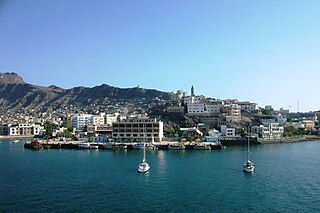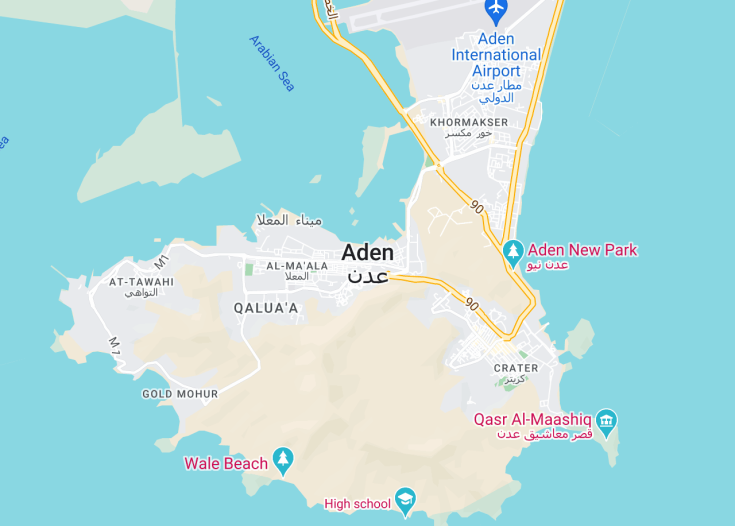Aden, a port city in Yemen, occupies a prime position on the ancient spice routes, offering a rich blend of culture, history, and natural beauty. This historic city serves as a gateway to the exotic Arabian Peninsula. Today, despite its complex history and current geopolitical tensions, Advisitors discover historical landmarks like the ancient Aden Crater, the bustling spice markets, and the picturesque old town. Aden’s diverse architectural landscape narrates tales of past civilizations, nestled beside Yemen’s scenic southern coastline, hinting at Egypt’s waterways with its turquoise waters and thriving marine life.
For an enriching visit, ensure to explore the Sira Fortress, offering panoramic views of the Gulf of Aden and insights into the city’s defensive history.
When visiting, keep in mind that morning hours are ideal for touring, as they allow you to enjoy the cooler temperatures and quieter streets.
Top things to do & see in Aden
Select the following sights and activities to discover best tickets and tours available in Aden.
Aden: The Port City of Rich History and Culture
| Country | Yemen |
| Time in Aden | GMT+3 |
| Language spoken | Arabic |
| Population | 803,000 (Source: World Population Review) |
| Currency | Yemeni Rial (YER ﷼) |
| Airports |
|
Located in Yemen, the historic city of Aden is an economic and cultural hub with a deep-rooted significance in maritime trade. Historically, it served as an important port city on the ancient spice routes, facilitating centuries of commerce between the East and the West. Its strategic location on the Gulf of Aden allowed it to prosper as a trading center, particularly during the 19th and 20ed from the dense Arabian Peninsula history.
Aden is more than just a gateway for trade; it has a rich cultural tapestry woven through its unique architecture, cuisine, and traditions. The city’s diverse population is reflected in its cultural festivals and daily life, representing a melting pot of Yemeni traditions and modern influences. Despite facing challenges, Aden continues to hold its place as a city of economic importance and cultural wealth.
Where is Aden?
Aden is strategically positioned in the southern part of Yemen, looking out over the Gulf of Aden.
Distances:
| Route | Distance by car | Time by car |
|---|---|---|
| Sana’a to Aden | 207 miles / 333 km | Approx. 8 hours |
| Taiz to Aden | 140 miles / 225 km | Approx. 5 hours |
| Hodeidah to Aden | 226 miles / 364 km | Approx. 9 hours |
What is Aden famous for?
Aden is renowned for its historical significance as a major port city on the maritime silk roads, playing a pivotal role in the spice trade and global maritime commerce.
History
Prehistoric and Ancient Times
The history of Aden, a remarkable port city in Yemen, is nothing short of fascinating, tracing back to antiquity. The area around Aden was known to be inhabited as early as the Paleolithic era, indicating a long-standing human presence motivated by its strategic location and natural harbor. It gained prominence in ancient times, primarily because of its role in maritime trade routes, linking the East and the West. Historical records from the Roman era describe Aden as a prosperous city that was a bustling center for the trade of spices and incense, pivotal commodities during that era.
Medieval Era: 7th to 15th Century
Aden rose to greater prominence following the arrival of Islam in the 7th century. It became an important transit hub for Muslim pilgrims traveling to Mecca. By the 12th century, under the rule of the Sulayhid dynasty, Aden had transformed into a thriving city-state, its wealth burgeoned by its strategic position on the spice trade routes between India, Arabia, and East Africa. This era also saw the construction of several key fortifications, including the famous cisterns of Tawila, crucial for collecting and storing rainwater.
Colonial Era: 19th to Mid-20th Century
The modern history of Aden took a pivotal turn in 1839 when the British East India Company captured the city, recognizing its importance as a station on the route to India. Aden officially became part of the British Empire, serving as a coaling station and later as the capital of the British Crown Colony of Aden. During this time, Aden’s port was considerably expanded and became one of the busiest shipping hubs in the world. Furthermore, the establishment of the oil refining industry in the mid-20th century added another layer to its economic fabric.
Recent History: Late 20th Century to Present
After gaining independence from British rule in 1967, Aden became the capital of the People’s Democratic Republic of Yemen. The city faced numerous challenges, including conflicts and political instability, particularly during the civil wars and the current ongoing conflict affecting Yemen. Despite these challenges, Aden remains a city of historical significance and continues to hold strategic economic and political importance in Yemen.
Visit Aden
What to see and do in Aden
Aden, with its unique blend of ancient and colonial heritage, offers a plethora of sights and activities for the curious traveler. Explore the Aden Crater, the remains of an ancient extinct volcano, for panoramic views of the city. The historic Tawila Tanks, an impressive ancient water collection system, should also be on any visitor’s itinerary. For those interested in historical architecture, the Sultan’s Palace, which now functions as the National Museum of Aden, offers insights into the region’s rich history and culture.
- Visit the bustling traditional markets like the Cisterns Market for local crafts.
- Explore the Aden Crater for a hike with a view.
- Relax at Gold Mohur Beach or Eleis Beach — popular spots for locals and tourists alike.
Festivals and Events in Aden
While Aden’s event calendar has been affected by ongoing instability, the city has a history of vibrant cultural expressions. Notable events, when they occur, include the Aden Festival, typically celebrated in the cooler months of November through January, showcasing traditional dances, music, and local crafts.
Best time to visit Aden
The best time to visit Aden is during the cooler months from November to March. During this period, the temperatures are more comfortable for exploring the city and its surroundings. The decrease in heat and humidity during these months makes it ideal for sightseeing and engaging in outdoor activities.
Is Aden worth visiting?
Aden, despite its tumultuous recent history, holds immense appeal for those interested in history, culture, and natural beauty. The unique blend of natural landscapes like volcanic craters and beaches alongside significant historical sites provides a compelling reason to visit. However, potential travelers must be mindful of the current political and security situation, which can present challenges. For the intrepid traveler, Aday’s rich heritage and natural beauty, contrasted with its urban dynamic, create a memorable experience that is worth the complexities of visiting such a place.










